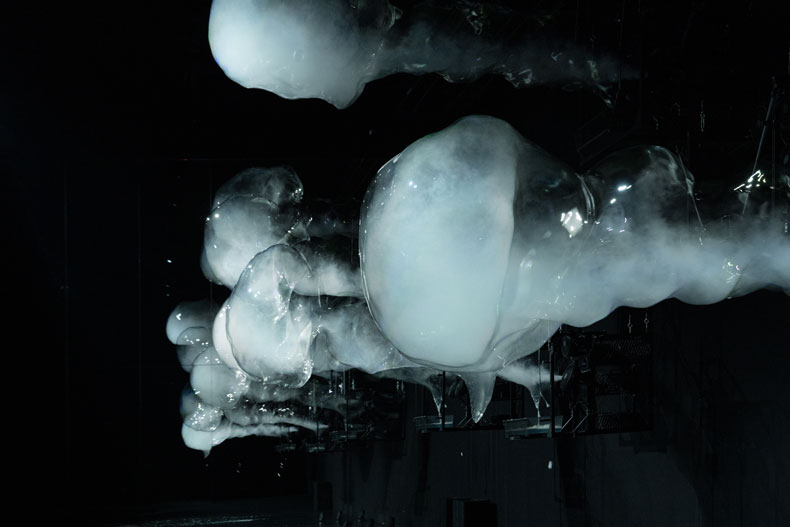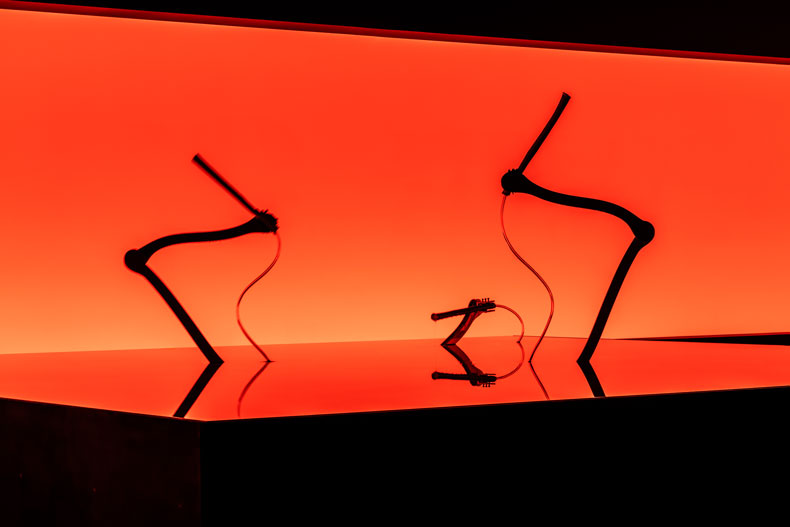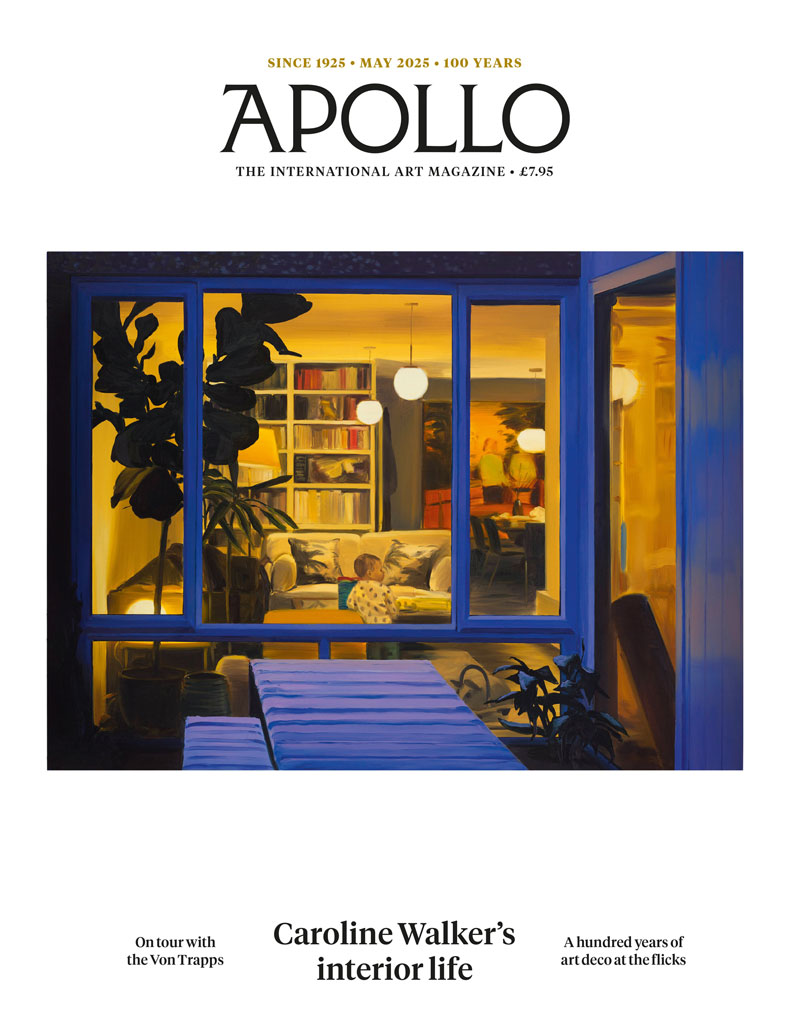Under the name A.A. Murakami, Alexander Groves and Azusa Murakami explore the boundaries between technology and nature, creating automated, technological works that are subject to the same physical laws – humidity, air turbulence, temperature – as our own bodies. During Milan Design Week in April, they showed two examples of their Ephemeral Tech series (2017–) at Opposites United, a festival of art, design, talks and music organised by the car company Kia at the city’s Museo della Permanente.
In The Cave, a new commission, arm-like machines enact a choreographed performance, rising and falling from a still liquid against a crimson screen, while bird-bone flutes and conch horns play a dream-like soundtrack. Beyond the Horizon comprises large, suspended, hauntingly embodied automata that waft amorphous fog-filled bubbles across the room, reflected in a wall of mirrors and lit by a cool blue light. Together, the works convey the melancholy beauty of a fleeting moment.
Beyond the Horizon is travelling to the Museum of Fine Arts in Houston for ‘Floating World’, A.A. Murakami’s first solo show in the United States (4 May–21 September).

Exhibition view of Beyond the Horizon (2024) by A.A. Murakami at ‘Opposites United’, presented by Kia Design at Milan Design Week 2025
Where is your studio?
Alexander: Our studio practice has never been typical – we were very nomadic until we had kids, so we worked wherever we happened to be, often in hotel rooms. After university, we moved to São Paulo, then to Shanghai. We’ve lived in Paris and New York. Each place has infused our practice. Then in 2020, we moved to Tokyo and stayed in Japan. We are now rooted there with our kids.
Tell me about your space.
Alexander: It’s part of our home in Hayama, which Azusa designed, about an hour’s drive from Tokyo in a forested valley by the beach. It’s a special place – the Japanese emperor’s summer house is nearby. We hike on the weekends and there’s a friendly farmer who gives us vegetables. We call our workspace a drawing studio: it’s just the two of us and it’s where we conceive ideas, discuss and refine them, and project-manage their fabrication. We still manufacture a lot in the UK, where we have a full-time engineer, but we have also started making things in Japan.
Tell me more about the house.
Azusa: I designed it to create maximum room on a very small plot of land, so I chose a builder that could span large spaces in wood without supporting columns. Everything is designed to optimise the views and the space and it’s a very comfortable home, but we haven’t done the interiors yet – it’s a blank canvas. That’s the next big project.

Exhibition view of The Cave (2025) by A.A. Murakami at ‘Opposites United’, presented by Kia Design at Milan Design Week 2025
Why did you choose to live in Hayama?
Azusa: Living there is restorative after being so nomadic for so many years, and it’s a great place to raise the kids. They play in the forests and on the beach at nursery and always come home with pockets full of acorns and shells. We have never felt we needed to be in a creative community, really, or in a city – the most important thing for us is to have some space and nature to work in.
How does the environment inspire your work?
Azusa: The views of the fields and forested hill rising above our house is very calming. When it rains, the hills on the other side of the valley seem smoky with mist. I enjoy making simple flower displays with things we pick – branches or sprays of pine in ceramic vases we find in antiques markets.
Alexander: When you walk into the forests around us you hear the clacking of the bamboo like a hollow xylophone, the swooshy leaves above and the quiet of the forest floor. The seasonal changes are very distinctive in Japan, and are marked by crickets in autumn or cicadas in the summer. Working between time zones we’re often in meetings with people in different countries, talking about a venue somewhere else, which means we’re mentally not present in our location – something I think we all experience. Being here makes you very aware of the parallel realm beyond your human world, and that’s very grounding.

Exhibition view of The Cave (2025) by A.A. Murakami at ‘Opposites United’, presented by Kia Design at Milan Design Week 2025
Tell me about your working day.
Alexander: I wake up at about 4:30am, or 4am in the summer, because that’s the only peaceful moment before the kids get up. I run on the beach, look at Mount Fuji, clear emails, soak rice. The kids wake at 6am and I’m with them for a couple of hours before taking them to nursery. Then I can actually start the work day, and it’s a sprint through the to-do list until the kids need to be picked up at 5pm. Work starts again at 9.30pm once they go to bed, because we have to do a lot of international calls.
Azusa: I get up around 6am and prepare the kids for nursery. Once they are dropped off we quickly clean the house, have breakfast and start work. I am productive as soon as I need to be, but I don’t really have habits to get me into a particular mode until it comes to picking up the kids again.
You work and live together. Do you always agree?
Alexander: On some things there’s an unspoken understanding that we agree, but other things need a lot of discussion. Ultimately, we end up making work neither would do alone.

Exhibition view of The Cave (2025) by A.A. Murakami at ‘Opposites United’, presented by Kia Design at Milan Design Week 2025




 A new look for Japanese art at the MFA Boston
A new look for Japanese art at the MFA Boston









![Masterpiece [Re]discovery 2022. Photo: Ben Fisher Photography, courtesy of Masterpiece London](http://zephr.apollo-magazine.com/wp-content/uploads/2022/07/MPL2022_4263.jpg)
Why it’s time to stop rediscovering Eileen Gray